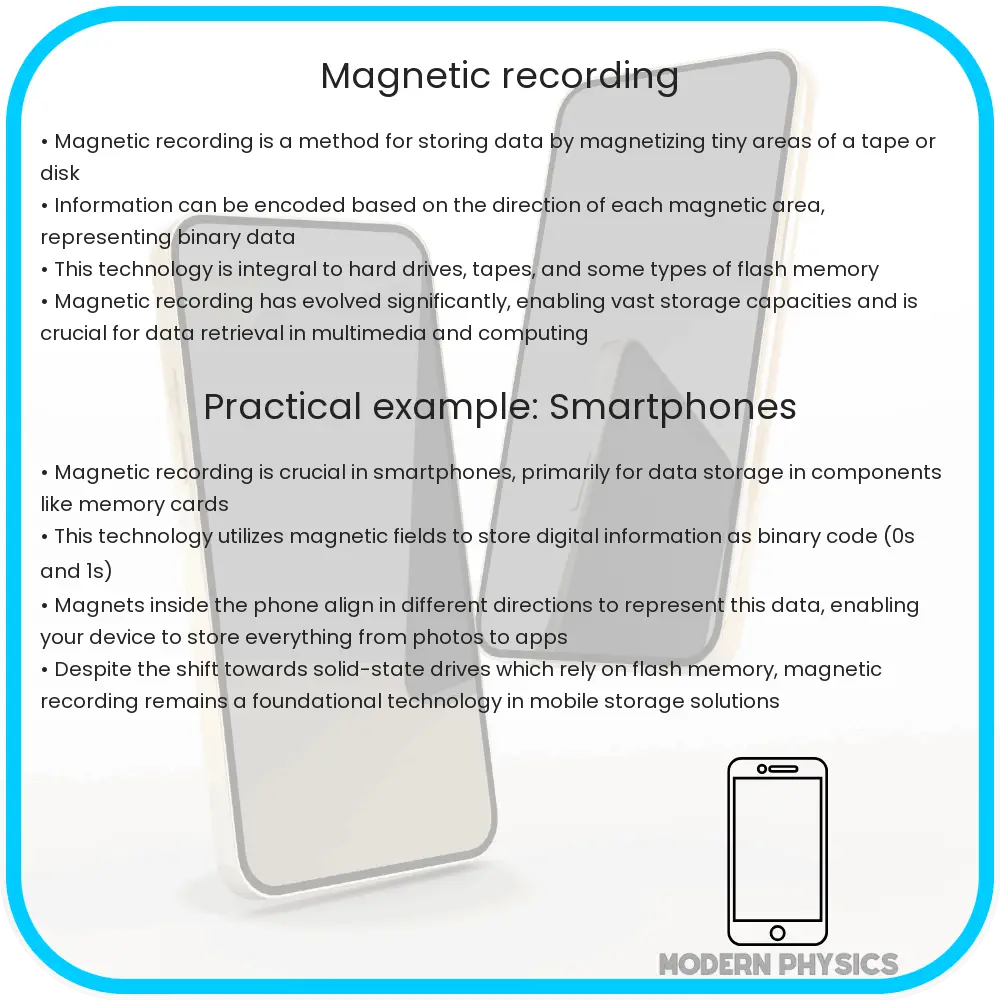Explore the intricacies of magnetic recording, focusing on durability, efficiency, and magnetostatics, in our comprehensive guide to data storage.

Magnetic Recording: Unveiling the Science of Durability and Efficiency
Magnetic recording technology, a cornerstone of data storage and retrieval, has continually evolved since its inception. This article delves into the principles of magnetic recording, focusing on the aspects of durability, efficiency, and magnetostatics, which are crucial for understanding modern storage devices.
Durability in Magnetic Recording
Durability is a paramount concern in magnetic recording. It refers to the longevity and reliability of the recorded information under various environmental conditions. The durability of a magnetic medium is influenced by factors such as the coercivity of the material, environmental stability, and resistance to physical wear and corrosion. Advanced materials like Iron(III) oxide (Fe2O3) and Barium ferrite (BaFe12O19) have been developed to enhance durability.
Efficiency in Data Storage
Efficiency in magnetic recording is gauged by the amount of data that can be stored in a given physical space, also known as data density. Advances in nanotechnology and material sciences have enabled the miniaturization of magnetic particles, allowing for higher density recording. Technologies like Perpendicular Magnetic Recording (PMR) and Heat-Assisted Magnetic Recording (HAMR) represent significant leaps in this area, offering substantial improvements in storage capacity.
Magnetostatics: The Fundamental Force
Magnetostatics plays a pivotal role in magnetic recording. It deals with the behavior of magnetic fields in the absence of changing currents. Understanding the principles of magnetostatics is crucial for designing magnetic recording systems, as it governs how magnetic fields interact with the recording medium. Key concepts include the magnetic field strength (H), magnetic flux density (B), and magnetic moments of particles, which determine the recording’s effectiveness and integrity.
Further, the concept of coercivity, the resistance of a magnetic material to changes in magnetization, is central to magnetostatics in recording media. Materials with high coercivity are less susceptible to unwanted demagnetization, thus ensuring the stability of the recorded data.
Continued research and development in these areas are critical for advancing magnetic recording technology, pushing the boundaries of data storage capabilities while maintaining the integrity and longevity of the information stored.
Advanced Techniques in Magnetic Recording
Emerging technologies in magnetic recording are setting new benchmarks in efficiency and durability. One such innovation is the development of shingled magnetic recording (SMR). SMR increases storage density by overlapping magnetic tracks slightly, akin to shingles on a roof. While this enhances storage capacity, it also presents challenges in terms of rewrite capability and data access speed.
Another notable advancement is Two-Dimensional Magnetic Recording (TDMR). TDMR employs multiple read/write heads operating in tandem, which improves signal processing and allows for even higher data densities. This technique is particularly effective in addressing the inter-track interference, a common issue in high-density recordings.
Environmental and Operational Considerations
The operational environment significantly impacts the performance and longevity of magnetic storage devices. Factors such as temperature, humidity, and exposure to magnetic fields can affect the stability of the recorded data. Manufacturers are increasingly focusing on creating more robust storage mediums that can withstand a wide range of environmental conditions without degradation in performance.
Additionally, the efficiency of magnetic recording devices is not solely dependent on the storage medium. The design of the read/write heads, the speed of the disk, and the efficiency of the data encoding algorithms play a critical role in the overall performance of the storage device.
Conclusion
The realm of magnetic recording stands at a fascinating juncture, marked by groundbreaking innovations in material science, data encoding techniques, and nanotechnology. The continuous push towards higher data densities, coupled with the need for durable and reliable storage, drives the evolution of this technology. While challenges such as data integrity, rewrite capabilities, and environmental susceptibility remain, the advancements in magnetic recording are a testament to the ingenuity and perseverance of scientists and engineers in this field.
As we venture further into the digital age, the importance of efficient and durable magnetic recording technology cannot be overstated. It is not just a matter of storing more data but doing so in a way that is sustainable, reliable, and accessible for future generations. The ongoing research and development in this area promise exciting possibilities, ensuring that magnetic recording continues to be a vital component in the data-driven landscape of the modern world.
